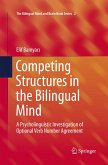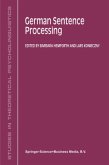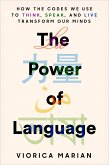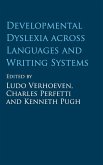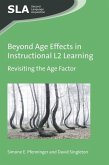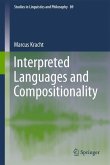Recursion Across Languages
The Intricacies of Babel
Herausgegeben:Bleotu, Adina Camelia; Foucault, Deborah; Roeper, Tom
Recursion Across Languages
The Intricacies of Babel
Herausgegeben:Bleotu, Adina Camelia; Foucault, Deborah; Roeper, Tom
- Gebundenes Buch
- Merkliste
- Auf die Merkliste
- Bewerten Bewerten
- Teilen
- Produkt teilen
- Produkterinnerung
- Produkterinnerung
This book explores how recursion our ability to embed structures within structures shapes human language. Bridging theory and experiment, it highlights two forms of recursion: direct recursion, which merges items directly, and indirect recursion, which embeds items within each other, showing that indirect recursion is sometimes treated as direct recursion in initial stages in acquisition. Drawing on cross-linguistic data from English, Mandarin, Hungarian, Romanian, Tamil, and other languages, the book reveals both universal patterns and language-specific variation in recursive structures such…mehr
Andere Kunden interessierten sich auch für
![Competing Structures in the Bilingual Mind Competing Structures in the Bilingual Mind]() Elif BamyaciCompeting Structures in the Bilingual Mind38,99 €
Elif BamyaciCompeting Structures in the Bilingual Mind38,99 €![Linguistic Theory for Aphasia Linguistic Theory for Aphasia]() Maria GarraffaLinguistic Theory for Aphasia31,99 €
Maria GarraffaLinguistic Theory for Aphasia31,99 €![German Sentence Processing German Sentence Processing]() German Sentence Processing113,99 €
German Sentence Processing113,99 €![The Power of Language The Power of Language]() Viorica MarianThe Power of Language13,99 €
Viorica MarianThe Power of Language13,99 €![Developmental Dyslexia across Languages and Writing Systems Developmental Dyslexia across Languages and Writing Systems]() Developmental Dyslexia across Languages and Writing Systems146,99 €
Developmental Dyslexia across Languages and Writing Systems146,99 €![Beyond Age Effects in Instructional L2 Learning Beyond Age Effects in Instructional L2 Learning]() Simone E. PfenningerBeyond Age Effects in Instructional L2 Learning181,99 €
Simone E. PfenningerBeyond Age Effects in Instructional L2 Learning181,99 €![Interpreted Languages and Compositionality Interpreted Languages and Compositionality]() Marcus KrachtInterpreted Languages and Compositionality77,99 €
Marcus KrachtInterpreted Languages and Compositionality77,99 €-
-
-
This book explores how recursion our ability to embed structures within structures shapes human language. Bridging theory and experiment, it highlights two forms of recursion: direct recursion, which merges items directly, and indirect recursion, which embeds items within each other, showing that indirect recursion is sometimes treated as direct recursion in initial stages in acquisition. Drawing on cross-linguistic data from English, Mandarin, Hungarian, Romanian, Tamil, and other languages, the book reveals both universal patterns and language-specific variation in recursive structures such as recursive possessives, prepositional phrases, adjectives, and relative clauses. Ideal for students and researchers in linguistics, the book integrates fresh insights from theoretical linguistics, psycholinguistics, and biolinguistics to provide a comprehensive view of how recursion is structured, acquired, and processed across languages.
Produktdetails
- Produktdetails
- Studies in Theoretical Psycholinguistics 51
- Verlag: Springer / Springer Nature Switzerland / Springer, Berlin
- Artikelnr. des Verlages: 89260174, 978-3-032-03572-1
- Seitenzahl: 349
- Erscheinungstermin: 9. Dezember 2025
- Englisch
- Abmessung: 235mm x 155mm
- ISBN-13: 9783032035721
- ISBN-10: 3032035724
- Artikelnr.: 74933676
- Herstellerkennzeichnung
- Springer-Verlag GmbH
- Tiergartenstr. 17
- 69121 Heidelberg
- ProductSafety@springernature.com
- Studies in Theoretical Psycholinguistics 51
- Verlag: Springer / Springer Nature Switzerland / Springer, Berlin
- Artikelnr. des Verlages: 89260174, 978-3-032-03572-1
- Seitenzahl: 349
- Erscheinungstermin: 9. Dezember 2025
- Englisch
- Abmessung: 235mm x 155mm
- ISBN-13: 9783032035721
- ISBN-10: 3032035724
- Artikelnr.: 74933676
- Herstellerkennzeichnung
- Springer-Verlag GmbH
- Tiergartenstr. 17
- 69121 Heidelberg
- ProductSafety@springernature.com
Adina Camelia Bleotu is currently Postdoc at the University of Vienna and teaches linguistics at the University of Bucharest. She earned her Ph.D. in 2015 from Ca' Foscari University, Venice, with a dissertation comparing morphological approaches to denominal verbs, later published as a monograph by Brill in 2019. Her research has since encompassed experimental studies on semantic and pragmatic phenomena in child language (at ZAS Berlin and the University of Bucharest), as well as psycholinguistic investigations of agreement attraction errors (during a Fulbright Grant at UMass Amherst). Her research has been published in journals such as Language Acquisition, Glossa, and Journal of Memory and Language. Over the past five years, she has focused on recursion, investigating the acquisition of recursive prepositional phrases, adjectives, relative clauses, and possessives in collaboration with Tom Roeper, Deborah Foucault, Usha Lakshmanan, and other researchers at the UMass Amherst Language Acquisition Lab. Deborah Foucault is Co-Director of the Language Acquisition Lab at UMass Amherst, Co-Director of the Language Acquisition Research Center, and Research Fellow with the Cognitive and Developmental Neuroscience Lab at UMass Amherst. She primarily conducts research on recursion and coordination (of adjectives, possessives, and relative clauses), as well as numeracy. Her broader research interests combine theoretical, experimental, and applied philosophy within Philosophy of Language/Linguistics, Education and Philosophy for Children, Philosophy of Science, and Conceptual Foundations of Science to better understand and create educational opportunities for young learners. Recent collaborations with Tom Roeper, Adina Camelia Bleotu, Usha Lakshmanan, Terue Nakato, a.o., on various studies have resulted in key insights and publications. Her work has been featured in language acquisition conferences such as GASLA, GALA, CLS, and LSA, as well as philosophical conferences such as APA. Tom Roeper is Professor of linguistics at UMass Amherst. He is Co-Director of the Language Acquisition Lab at UMass Amherst. He has dedicated his career to uncovering the intricate ways in which children acquire language, bringing together theoretical rigor and experimental insight. His research spans a wide range of topics—from recursion and wh-movement to implicit arguments and suffixation—across languages as diverse as English, Afro-American English, Chinese, Japanese, Brazilian Portuguese, and Romanian, among others. His work has appeared in leading journals such as Lingua, Language Acquisition, Linguistic Inquiry, and Biolinguistics. His collaborative spirit is reflected in his many collaborations, including those with William Snyder, Bart Hollebrandse, Terue Nakato, Deborah Foucault, Adina Camelia Bleotu, through which he has explored the universal nature and language-specific variation of recursion in child language.
Chapter 1 Introduction.- Part I: Insights into the Theory of Recursion.- Chapter 2 How Minimalism Captures the Emergence of Categorical Recursion in Acquisition.- Chapter 3 Recursion, Coordinate NPs, and the Acquisition Path.- Chapter 4 Toward the Construction of a Formal Definition/Classification System for Recursion.- Chapter 5 The Category Hybridization Hypothesis and S-nominalization: A New Approach to Clausal Gerunds.- Chapter 6 Recursion in Language and Beyond: A Biolinguistic Perspective.- Part II: Psycholinguistic Perspectives on Recursion.- Chapter 7 The Grammar of Unanalyzable Sentences in Early Child Language Production: Production Mismatches in the Development of Recursion in English.- Chapter 8 The Cat s (and) Dog s Bear: Children s Planning of Conjoined and Embedded Recursive Possessives.- Chapter 9 Not Noticing the Evidence: How Big are Illusion Effects on Coordination, Adjunction and Embedding?.- Chapter 10 The Recursive Set-Subset Ordering Restriction and adjectives in child Romanian.- Chapter 11 Set-Subset Relative Gradable Adjective Recursion is More Challenging Than Possessive Recursion for Both Monolingual and Bilingual English-Speaking Children.- Chapter 12 Generic Possessives and the Acquisition of Recursive Possessives in English.- Chapter 13 Tamil Children s Comprehension of Recursive phrases: Evidence from Possessives, Locatives and Relativized Sentences.- Chapter 14 Recursion and Verb Stacking in Tamil and Their Acquisition.- Chapter 15 Sound, Meaning and Recursion.- Chapter 16 Exploring the Shared Developmental Path of Recursion: Insights from Acquiring Chinese DeP Recursion.- Chapter 17 Recursion in Children s Hungarian. The Acquisition of Complex PPs and Recursive Possessives.
Chapter 1 Introduction.- Part I: Insights into the Theory of Recursion.- Chapter 2 How Minimalism Captures the Emergence of Categorical Recursion in Acquisition.- Chapter 3 Recursion, Coordinate NPs, and the Acquisition Path.- Chapter 4 Toward the Construction of a Formal Definition/Classification System for Recursion.- Chapter 5 The Category Hybridization Hypothesis and S-nominalization: A New Approach to Clausal Gerunds.- Chapter 6 Recursion in Language and Beyond: A Biolinguistic Perspective.- Part II: Psycholinguistic Perspectives on Recursion.- Chapter 7 The Grammar of Unanalyzable Sentences in Early Child Language Production: Production Mismatches in the Development of Recursion in English.- Chapter 8 The Cat s (and) Dog s Bear: Children s Planning of Conjoined and Embedded Recursive Possessives.- Chapter 9 Not Noticing the Evidence: How Big are Illusion Effects on Coordination, Adjunction and Embedding?.- Chapter 10 The Recursive Set-Subset Ordering Restriction and adjectives in child Romanian.- Chapter 11 Set-Subset Relative Gradable Adjective Recursion is More Challenging Than Possessive Recursion for Both Monolingual and Bilingual English-Speaking Children.- Chapter 12 Generic Possessives and the Acquisition of Recursive Possessives in English.- Chapter 13 Tamil Children s Comprehension of Recursive phrases: Evidence from Possessives, Locatives and Relativized Sentences.- Chapter 14 Recursion and Verb Stacking in Tamil and Their Acquisition.- Chapter 15 Sound, Meaning and Recursion.- Chapter 16 Exploring the Shared Developmental Path of Recursion: Insights from Acquiring Chinese DeP Recursion.- Chapter 17 Recursion in Children s Hungarian. The Acquisition of Complex PPs and Recursive Possessives.


